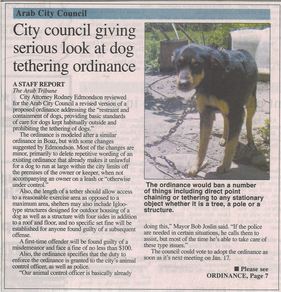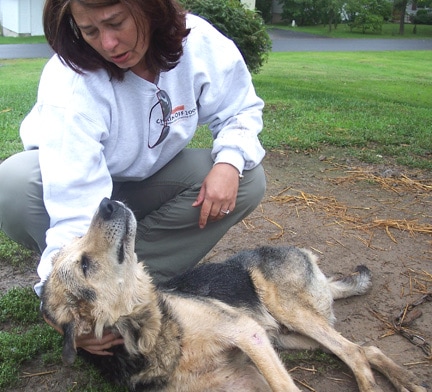 I have been working on advancing a dog ordinance in the city where I live for about a year and a half. It is set on the agenda for the city council meeting next week for a first reading. If all goes as I hope, the ordinance will be adopted later this month or in early February. My pitch to my mayor and city council members for the ordinance covered four points: public safety, animal welfare, property resale potential and community pride. I already have a page on my website about chaining dogs and I have another page about dog aggression, on which I cover the story of a WWII veteran named Donald Thomas who was attacked and killed by two dogs in Leeds, Alabama in September of 2012 when he went to check the mail. Our law firm handled the defense of a civil lawsuit against the City of Leeds. It was truly one of the most tragic and gruesome cases I have ever been involved with in over 20 years as a paralegal. Some push-back I got recently about my dog ordinance from a woman in our city considered an authority on all things animal led me to cover this topic in a blog to help make the case for ordinances like the one I developed. The complete ordinance is found here. The provisions are pretty simple and not at all unreasonable as far as I am concerned. If your dog lives inside, you are free to care for that dog any way you see fit. I would hope your dog is well fed, receives proper veterinary care and is treated as a member of your family. If your dog lives outside, that is another matter entirely. The ordinance sets forth the methods by which a dog who lives perpetually outside may be contained and may not be contained and it sets forth basic standards for housing and care. The state laws in Alabama do not currently define what constitutes shelter, are pretty lax related to what constitutes neglect, abuse and cruelty and do not prohibit direct point chaining or tethering of dogs. While I have every reason to believe a bill will be pre-filed by a state representative any day now which would prohibit chaining and tethering in all of Alabama, I wanted to take steps in my own community to set some basic standards.  So, why is it any business of any government, local or state, how you treat your dog? Here’s why. Public Safety. Your dog may not be dangerous to you, but your dog can be dangerous to other people. Because of the chained dog’s minimal physical space and lack of socialization, these animals often become exceedingly hyper and aggressive. Dogs who are "resident" dogs do not learn to become protective of the people who own them who are living in a house. They learn to become protective of the area in which they are forced to live. The reasons for actual dog attacks (as opposed to incidents of simple and avoidable injuries) are often complex, but the answer to preventing dog attacks is relatively simple: humane care and control of dogs is often all that is needed to prevent most dog attacks. A study by the The Journal of the American Veterinary Medical Association (JAVMA) in 2013 revealed the following statistics related to bite fatalities: no able bodied person being present to intervene (87.1%); the victim having no familiar relationship with the dog(s) (85.2%); the dog(s), owner failing to neuter/spay the dog(s)(84.4%); a victim’s compromised ability, whether based on age or physical condition, to manage their interactions with the dog(s) (77.4%); the owner keeping dog(s) as resident dog(s), rather than as family pet(s) (76.2%); the owner’s prior mismanagement of the dog(s) (37.5%); and the owner’s abuse or neglect of dog(s) (21.1%). Four or more of these factors were present in 80.5% of cases; breed was not one of those factors. Animal welfare. Dogs thrive on interaction with human beings and other animals. They need regular interaction with their family members. A dog kept chained (or confined to a pen 24/7/365) whether for hours, days, months, or years can suffer tremendous psychological damage. These sensitive and loving animals desire and deserve as much comfort and happiness as beloved indoor companion animals. Many chained dogs spend their lives connected to a six-foot or shorter metal chain. Under these limited conditions, dogs are forced to eat, drink, urinate, defecate, and sleep with no respite or companionship. They often suffer through blistering heat and freezing cold, rain, snow, and wind. Their "home" can turn into a filthy muddy mess, dust bowl, or frozen landscape. Feeling vulnerable and threatened on a daily basis, many chained dogs will lunge at anything that goes by them. The constant lunging often causes the dog’s collar to tear into the skin and can, in some cases, become embedded in the dog’s neck, requiring surgery to remove the collar. In some extreme cases, the straining may cause injury or even death to the dog. Some dogs choke to death when they attempt to jump over fences and hang themselves. Chained dogs are caught in a vicious cycle. The longer they stay chained, the less likely they are to have human companionship, thereby making it more difficult to handle them. The more difficult they become, the less likely a human will want to engage with them. They are caught in a downward spiral, not of their own making. The Humane Society of the United States, the U. S. Department of Agriculture, the ASPCA, the American Veterinary Medical Association and numerous animal experts have spoken out against chaining and tethering because it is inhumane and can lead to aggressive behavior. The Centers for Disease Control (CDC) concluded in a study that the dogs most likely to attack are male, unneutered and chained. Part of the opposition I got to my ordinance related to people’s inability to financially be able to comply. I know that there are cultural differences between generations and in some states related to dogs as inside animals v. as outside animals. I read a position once which said, "no animal is coming inside my house unless it’s going on a plate." I understand that people have different ideas on that subject. But having your dog live outside is a choice. If your dog lives inside and is part of your family, you have fewer expenditures to keep your dog contained. If your dog lives outside, there may be costs tied to that from providing adequate shelter or providing adequate containment if your yard is not fenced. I have a trolley line in the trunk of my car which I have been taking to city council meetings as a visual aid. It got it from Walmart for $15. If you choose to have your dog live outside, I want you to take care of your dog and help keep our communities safe. If are you are not willing to do both of those things, perhaps having a dog is not the best choice for you. We call them man’s best friend. We need to treat them that way and we need to be mindful of how our choices affect those around us. (images courtesy of Tamira Ci Thayne and Dogs Deserve Better, Inc.)
0 Comments
Your comment will be posted after it is approved.
Leave a Reply. |
AuthorI am an animal welfare advocate. My goal is to help people understand some basic issues related to companion animals in America. Awareness leads to education leads to action leads to change. Archives
July 2024
Categories
All
image courtesy of Terrah Johnson
|

 RSS Feed
RSS Feed